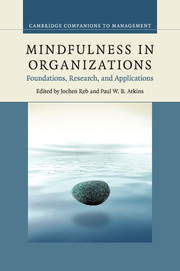Book contents
- Frontmatter
- Contents
- List of figures
- List of tables
- List of contributors
- Foreword
- Preface
- Part I Foundations
- Part II Research
- 6 Mindfulness, identity and work: mindfulness training creates a more flexible sense of self
- 7 Improving decision making through mindfulness
- 8 Mindfulness and creativity in the workplace
- 9 How being mindful impacts individuals' work-family balance, conflict, and enrichment: a review of existing evidence, mechanisms and future directions
- 10 Building and maintaining better leadership relationships through mindfulness
- 11 Leading with mindfulness: exploring the relation of mindfulness with leadership behaviors, styles, and development
- 12 Mindfulness in interpersonal negotiations: delineating the concept of mindfulness and proposing a mindful, relational self-regulation (MRSR) model
- 13 Drawing the line: sketching out the role of visual templates in individual mindfulness and mindful organizing
- Part III Applications
- Index
- References
7 - Improving decision making through mindfulness
from Part II - Research
Published online by Cambridge University Press: 05 July 2015
- Frontmatter
- Contents
- List of figures
- List of tables
- List of contributors
- Foreword
- Preface
- Part I Foundations
- Part II Research
- 6 Mindfulness, identity and work: mindfulness training creates a more flexible sense of self
- 7 Improving decision making through mindfulness
- 8 Mindfulness and creativity in the workplace
- 9 How being mindful impacts individuals' work-family balance, conflict, and enrichment: a review of existing evidence, mechanisms and future directions
- 10 Building and maintaining better leadership relationships through mindfulness
- 11 Leading with mindfulness: exploring the relation of mindfulness with leadership behaviors, styles, and development
- 12 Mindfulness in interpersonal negotiations: delineating the concept of mindfulness and proposing a mindful, relational self-regulation (MRSR) model
- 13 Drawing the line: sketching out the role of visual templates in individual mindfulness and mindful organizing
- Part III Applications
- Index
- References
Summary
“Most men's awareness doesn's extend past their dinner plates.”
Scott Westerfeld, Leviathan
Introduction
With perhaps a few exceptions per day, we are seldom fully aware of our thoughts, actions, emotions, and what is happening around us. Even when it comes to making decisions, an activity that is often quite conscious, deliberate, and intentional, people are typically not as aware as they could be. We argue that as a result, decision quality may suffer. Consequently, mindfulness, most often defined as the state of being openly attentive to and aware of what is taking place in the present, both internally and externally (e.g., Brown and Ryan 2003; Kabat-Zinn 1982; 1990), can help people make better decisions. Making judgments and decisions is a fundamental human activity in both personal and organizational contexts. Decisions hold the potential for great gains: marrying the right person, accepting a job that fits well, putting one's savings into the right investments, or choosing the appropriate strategy for an organization. Decisions also hold the potential for great loss, pain, and suffering. Wrong decisions can destroy people, families, and organizations. People are haunted by rumination, even depression, looking back with regret at some of the decisions they made. Organizations are also a place of great decision blunders, such as the “merger” between Daimler Benz and Chrysler, or Coca Cola's decision to introduce New Coke.
Decision research has generally painted a rather bleak picture of individual and organizational decision-making capabilities, compiling a long list of biases (i.e. systematic errors) and problems such as overconfidence, confirmation bias, or the sunk cost bias (Kahneman 2011). Arguably, errors are partly due to the daunting difficulty of decision making: the need to process large amounts of information with limited capacity and time, the need to be clear about one's values and objectives, and the need to make difficult trade-offs. We believe that if mindfulness helps even to a small extent to improve decision making, individuals and organizations stand to gain considerable accumulated benefits.
- Type
- Chapter
- Information
- Mindfulness in OrganizationsFoundations, Research, and Applications, pp. 163 - 189Publisher: Cambridge University PressPrint publication year: 2015
References
- 39
- Cited by



